Vol. 2, Issue 35 - September / October 2011
Posted: Monday 12th September 2011
Tom Culver organises an event here called the Cambridge 50 which is for veteran cycles but also encompasses his other love – Moultons. Taking this into account I decided to ride my modern build, but Old Skool (1948 Higgins Ultralite) fixie complete with SPD pedals. Patricia had to leave for Oxford in the afternoon so we did the morning ride to lunch at Ely which uses the off road riverside cycle path, with stunning views of Ely cathedral. The 20+ mile ride was very enjoyable on fixed and the bullhorn bars proved very comfortable. I usually ride one of my period-correct fixed-wheel bikes on this ride but the few non-period parts did give a different feel, mainly the pedals and bars.
The bars were originally Maes which were turned upwards and sawn off just into the bend giving the appearance of a pair of bullhorns as used by time triallists in years gone by. They were taped with modern tape and I must admit the ride position was very comfortable. A hard-riding member of our local CTC always uses these bars on his bike and I had wondered why until I tried the format for myself. He has gears, so a pair of bar-end brake levers, whereas I have just a stubby single brake near the stem to complement the fixed gear braking.
A recent innovation with bars on modern road machines is of using a shallow drop and a flatter top section. This resultant flat section, along with new refined brake hood positions, give a flat area for the hands, not unlike the bullhorns. The modern profile also provides a very comfortable position when riding on the tops, in the same way as the bullhorns.
In CLN 34 I mentioned that we had taken a holiday with our bikes in Italy. We had a few emails asking for more information so here are the brief details. We flew from Stansted to Brindisi in Puglia, in the Italian South (we could have gone to Bari, same distance from Ostuni) and took a taxi from the airport to our hotel in the old centre of Ostuni. This pick-up was arranged by the hotel – a great saving as airport taxi rates are often up to double normal rates. As usual, we took our Airnimal folding bikes which reduce down into a suitcase for easy transport. Being in the old part of the town the roads to the hotel were barely the width of a Fiat Cinquencento so there was very little traffic. At the bottom of the hill from the hotel was a historic area which had enough restaurants and shops to keep us going for the entire stay.
On our first day we visited the information centre where we were given a leaflet of cycle routes in the area which turned out very useful used in conjunction with the maps we took with us. The area North of Ostuni towards Alberobello is famous for its round houses known as trulli: there are several images available for viewing at http://www.facebook.com/media/set/?set=a.209899045709447.62954.100000680600553
For the duration of our stay we were able to cycle on very quiet rural roads and even a trip along the coast road to Monopoli on a Sunday was comfortable. We were in Italy from 3 – 10 May and we found that the area was very quiet as visitors had not yet started to crowd in. We also found that the restaurants were virtually empty until about 8.30 in the evening which called for patience as we were often hungry by about 6 o’clock.
We had not realised that this area was so popular with organised cycle tour companies and most of the local tourist trade at this time of year seemed to come from the nightly influx of cyclist groups with riders from all over Europe, America, New Zealand and Australia. We were surprised that these groups had travelled from A to B by the main roads, maybe as a result of being let loose with maps to find their way round, until they met their luggage and guide at the next hotel. I suppose the advantage of this ‘ride yourself’ system is that riders of differing abilities were able to form small groups travelling at a speed to suit them.
I seems strange to write about Italy as we have just returned from our second holiday of the year in Bavaria. For this break we had rented a small van and holidayed on the Romantische Strasse (Romantic Road) which is a cycle route down the medieval trading route through Southern Germany. We were pleasantly surprised to find that our first accommodation was within 200 metres of the local wine producing plant which produced some very tasty wines. We keep on finding pockets of wine production in Germany producing some exceptional wines, both red and white. I assume these wines are all sold locally as it is very hard to find any for sale in the UK and on the rare occasions when they are they fetch at least three or four times the price.
On our second day’s ride along the Tauber valley we came across a two-up time-trial organised by the village of Distelhausen. We realised that something was afoot when we found our path blocked by the friendly local fire brigade who were acting as marshals. We made our way to the start/finish area which was at a local village hall turned into a party venue for the occasion in a typical Bavarian way! The local fixed-wheel and single-speed riders had organised an event for themselves within the main competition and we had a long chat about their bikes and the conversions to fixed – having said that, most of them were riding single-speed free for the event as it had some steep hills and much time would have been lost twiddling frantically on the descents. The prize for their part of the event was a two-metre high pile of crates of local beer, which must have done the training some good.
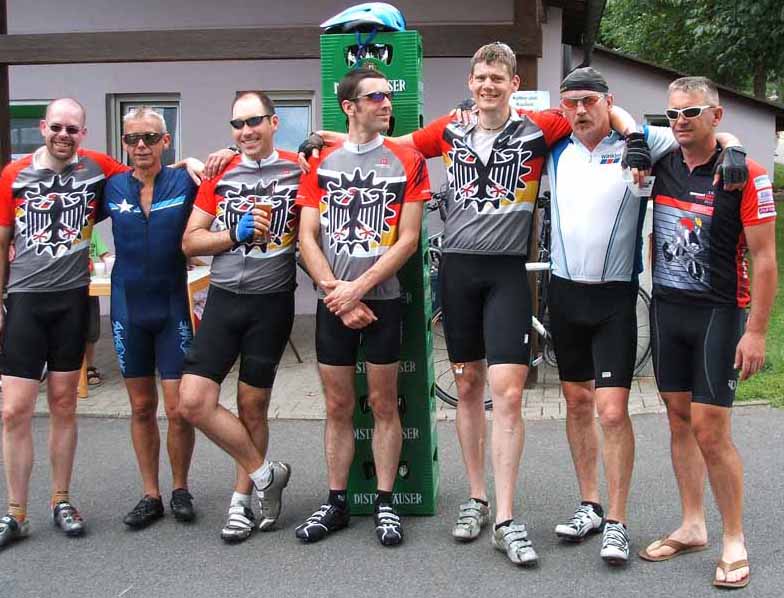
We found that the top-half of the route from Wertheim to Rothenburg was extremely well signed with arrows at every junction but south of this stretch when it entered a different administrative area it was more hit and miss. A bike coach runs the length of the route. At Donauwerth on the Danube we put our bikes on the racks at the rear to return in comfort to our starting point. We had booked all of this online before leaving the UK and were very impressed by the organisation.
We then moved South and rode some of the southern stretch of the Romantische Strasse including the lovely area towards Füssen. With another week’s holiday left we moved on to an area of Bavaria we had skirted in the past but never visited, a few kilometres from Murnau (on rail line from Munich and Oberammergau. We stayed in Bad Kohlgrub, not much more than a village but with a good choice of restaurants. A branch line train (with room for about twenty bikes) runs from Oberammergau to Murnau and the town is about half way it. The cycling in this area is fantastic, hilly but not killing. Our accommodation was a guest house http://www.gaestehaus-alpina.com/ run by a family who all cycled on both road and mountain bikes. We hope to return at a later date.
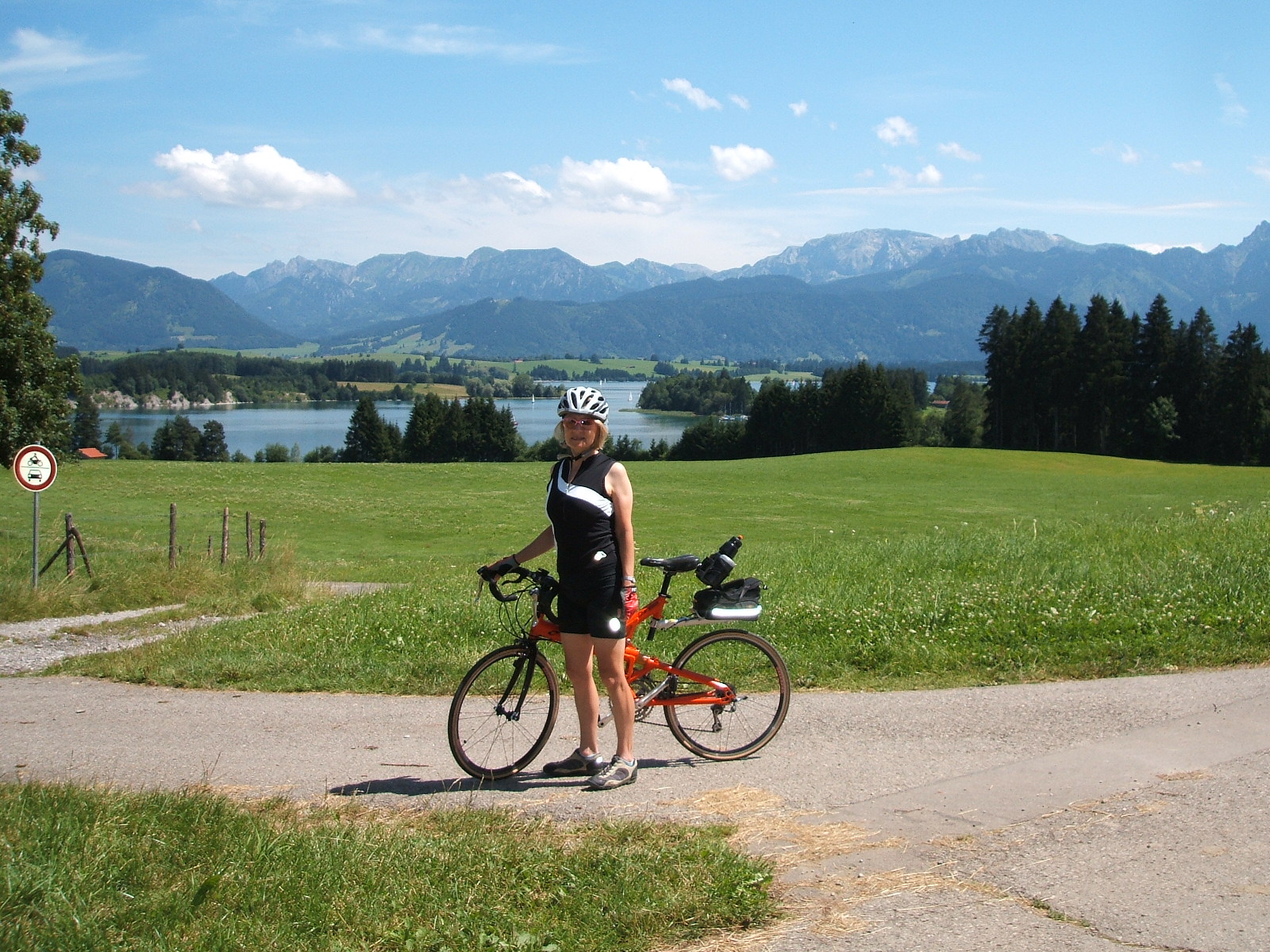
Retro Racing Revival in Redbridge
Saturday 1st October 2011:
VHCRC (Veteran-Historic Cycle & Racing Club) Retro-Racing at Redbridge 12.30 to 4.30pm
V-CC members and friends are invited to the Redbridge Cycle Centre (a.k.a. Hog Hill Circuit), Forest Road, Hainault, Ilford, IG6 3HP, for an afternoon of friendly racing on pre-1975 machines. The programme for the day will include a time-trial handicap (handicap based on combined age of machine and rider; bring your oldest bike for greatest advantage!), races for hub-geared, rod-braked, solid-tyred, pre-1940 and Raleigh sports machines (clones by Humber, Rudge, etc included). The highlight will be the Grand Old Ordinary One-Mile Championship. Children’s and youths’ races will be included, depending on the attendance. There will be a charge of £3 per entrant for the hire of the track, plus £2 per entrant for 1-day TLI membership for insurance purposes.
For directions see Redbridge Cycle Centre:
http://www.vision-rcl.org.uk/redbridge_cycle_centre.html
Sunday 11 September – Cambridge Section – Ephgrave Lightweight Ride. This year we are using our ‘hilly circuit’ for the Ephgrave Ride of about 30 miles. However, it has been ridden on fixed with no problems by some fit riders. Other classic lightweights welcome, of course.
Start at 10am at Whittlesford Parkway Railway Station Car Park (£1 for day) – leave Junc. 10 of M11 towards East at its intersection with the A505. Leave A505 at second junction SP ‘Whittlesford/Shelfords’ – then shortly take 1st Right SP ‘Station’. This railway station bisects the road – we use the side nearest Duxford Air Museum/M11 ( SatNav will take you to the other side – the post code for the vets surgery which is at the start is CB22 4NL Station Road West). Every year we have to extract a few riders from the other side of the railway line so if you are near a new hotel then you are on the wrong side.
Lunch at the excellent Ickleton Lion, either inside or out depending on the weather. Sorry but no coffee stop or toilets at the start. I am told there are facilities at a MacDonalds a few hundred yards along the A505 travelling East.
Scanning through Sporting Cyclist for 1956/57 I noticed that Stronglight advertised in every edition but only displayed their steel 3-arm cottered chainsets although they had produced the popular alloy cotterless cranks for years. Maybe they were pushing the set which came with Stronglight chainrings whereas their alloy 5-pin cranks were mainly used with TA alloy single, double or triple rings.
This craftily leads to more matters French, also referring to chainsets. I was recently reading in the latest edition of Bicycle Quarterly (USA) about the restoration of a 1948 Rene Herse tandem by the editor. Perhaps I should point out here that I know little or nothing about French machines but was interested in the lengths to which Jan Heine went to get an authentic restoration of this machine with its history of top level randonneurs including the Paris-Brest-Paris. This machine was equipped with Rene Herse chainsets but the layout puzzled me. Some tandems have an in-line RH drive which has a double chainset at the front connected to the inner rear RH drive double chainset (with matching ring size of course) and then by an outer ring from the rear to the drive on the rear wheel.

The front bottom bracket has an eccentric fitting to allow the chain distance between the two rings to be adjusted (see below for detail).
Others seen in the UK sport a cross-over drive where the front chainring is on the left side of the bottom bracket and the chain connects this to the left side rear chainring which then has a second ring on the right to drive the rear wheel. In both of these examples the final drive is from the rear chainring to the rear wheel – quite normal even by solo standards.

What I saw on Jan’s Herse was that the two chainsets were connected on the left as in the above example but that the final drive to the rear wheel went from the front right hand chainset to the rear wheel giving an exceptionally long chain drive using a chain more than double that of a solo.

The only reason I can see for this is that maybe in this early period this set-up gave a smoother working double front change and removed the problems of chain alignment with derailleur gears on a relatively short rear triangle. The derailleur, mounted on its own bracket, would need quite a bit of tension to avoid chain sag along the bottom run. The two springs to give this tension can be seen below the chainstay.
An eccentric bottom bracket is needed on all of these drives in order to adjust for chain length between the two bottom brackets. Normally the front BB is eccentric.
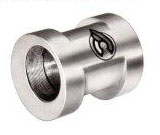
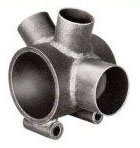
On our website there is however a Pennine tandem which has a sprung tensioner to take up the slack between the front and the rear rings. This would have save the builder the task of fitting the non-standard eccentric BB – possibly the sign of a builder producing just one or two tandems and not wanting to go into this unknown area of construction.
As a result of researching this I came across an entry in Sporting Cyclist, July 1957, relating to an event known as the 38th Criterium de la Polymultipliée which touches on an aspect of cycling history which concerns us today. This competitive event was used as a testing ground for some of the first derailleur type gears over many years. The first event was held in 1913 using a 10km circuit close to Paris and incorporating a severe long hill which was covered in each of the fifteen laps.
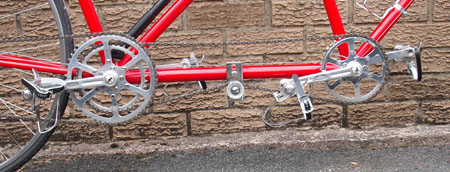
The event was to test various types of gears in competition, making it a battleground for gear manufacturers over the years. For many years the event was won by teams using double-frees, a freewheel with two sprockets often 17/20. At the bottom and top of the climb they dismounted, released the rear wheel in the rear ends, manually changed to the other sprocket, secured the wheel and carried on. One can imagine getting quite slick at this with some practice!
Some ten years later the event was still won by single/double free, nearly killing the top riders in the process but in the lower categories the riders finished in the tourist class much fresher and in a time quite close to the winners – the penny began to drop. They were riding derailleur gears.
After this the derailleur became the norm and the gear manufacturers entered crack teams in an attempt to establish superiority for their brand. This went on for another ten years but by now the use of gears was accepted in the Tour de France which became the ultimate testing ground.
The ‘Poly’, however, carried on and was watched by thousands who were able to cycle out or catch trains from Paris to the circuit a few miles from the city. In the 1950s many of the top French professionals would ride the event which was marshalled by gendarmes on motor cycles.
I would like to know how long the Poly continued after the late 1950s.
Thank you Peter for that interesting little scan. It refers to a time before my arrival in Australia, but I have always been impressed by the enthusiasm and dedication to the sport both by the Amateurs and the Professionals when that was relevant. There has been here a culture that is different from UK. Aided of course by the massed start races being on open roads and the fact that many country towns have a respectable track. Some towns even boast two clubs and they fight about the use of the track.
Right now in Melbourne we can boast two!! indoor board tracks, though one is only used for elite events such as world cups etc. But the other is a good, nay superior quality board track used for training every day of the week all hours of the day.
I do not know how many outdoor tracks we currently have operating in Melbourne but 4 come instantly to mind. The old board track that was used for the Olympic Games in 1956 was removed in the late 60s or so. Still in use till the end. Amused/pleased to read of efforts to restore Herne Hill. Once again, fond memories. Patterson, Harris, Van Vliet, Gerardin at that track.
A couple of years ago we held a memorial ride for Russell Mockridge. It was the 50th anniversary of the accident when and where he was killed. We all rode vintage bikes from the era. I rode my Stallard Zakopane. There were about five or so riders from the fatal day present. We had a short ride from the race start to the accident site. A short remembrance and ride back. Police escort was nice. Russell’s regular companion in the scratch bunch at that time was Jim Taylor. He rode with us on the bike that he had used for his legendary Warrnambool ride the previous year. Legendary because that was the day Mockridge and Taylor were handicapped to start “behind scratch” and gained first and second fastest time with Taylor winning the 150-mile championship on the way with an average speed of 43.4 kph for the 265 km event. The memorial ride was the first time that he was able to bear to be at the site since the accident. He was injured in the accident and never rode as well again in my opinion.
When the Essendon board track was operating (Essendon is a Northern suburb of Melbourne) Reg Harris was here. He competed much as the paper described both in Melbourne and in Geelong a regional city about 40+ kms from Melbourne. Many colourful tales abound about his time here. I do not think that he won many races but I am sure that he had a good time and enjoyed himself.
I have just read, with interest, through Steve Griffiths’ article on Harden hubs. I raced on a pair for a couple of years, 1960-62, on the road. I made my own axles, and used Campagnolo skewers. They worked extremely well, right up to the time that the bike was stolen. I weighed only 9 stone 4 pounds, so I may not have been a fair test. However, the only valid criticism that I have found of Harden hubs is the fitting of removable steel races in a soft aluminium hub; they eventually became loose. Axles could be replaced, not so the hub.
I am back on the road, after nearly fifty years, and will tackle the Grafton to Inverell next year, my jubilee; I won it off handicap in 1962.
I am setting up my Conloys! The Bayliss-Wiley high flanges front hub off my old road bike. This is fitted with a hand-made axle and Shimano skewer. My ‘matching’ rear hub was an Airlite, high flange, Shimano axle (I think), and Shimano skewer, which I still have. We are building an ‘Airlite look alike’ freehub, with high flanges, to set up the rear wheel, modern 40 hole hubs being unavailable here in Australia. It will have a polished stainless steel centre tube and Airlite size flanges. Airlite would probably not recognise the thing, given modern spacings, but it is as ‘look alike’ as I can manage. I shall, incidentally, ride a 1960 Jim Bundy (western Sydney, and still building) frame, Reynolds 531 tubing, modified lightly, and with current running gear.
Ed: I have never heard of Hardens being converted to quick-release before, an interesting project.
Marc Rerceretnam from Sydney NSW has a lightweight bike which looks as if it is from a decent manufacturer – one of many with Nervex Professional lugs. The main hope of identifying rests in the stampings on the BB and seat tube. There are no identifiers apart from an “A” stamped on the top end of the seat post downtube and a large “31” and a tiny star and 3 leaf clover above it (about 3mm across each) stamped in the bottom bracket. Does this ring a bell with anyone?
marc@hwy.com.au
This completes our hat-trick of letters from down-under!
I am looking for a 32 hole Mavic MA2 700 silver polished rim in new or very good condition.
Posted: Monday 12th September 2011
Contents
- Introduction
- Information Centre
- Coast Road To Monopoli
- Romantische Strasse
- Route From Wertheim To Rothenburg
- Patricia
- Retro Racing Revival
- Ickleton Lion
- Sporting Cyclist
- Mercian Tandem
- Bottom Bracket
- Crossover Drive
- Jan’s Herse
- The Competition Bicycle
- Eccentric Bottom Bracket
- Images
- Pennine Tandem
- Pennine Tandem Drive
- The Event
- John Conway
- Phil Chapman
- Marc Rerceretnam
This article appears in the following categories.
Upcoming Events
Whether you are looking for a gentle social meet up, or a 100-mile ride browse the community’s upcoming events and plan your next weekend outing.
